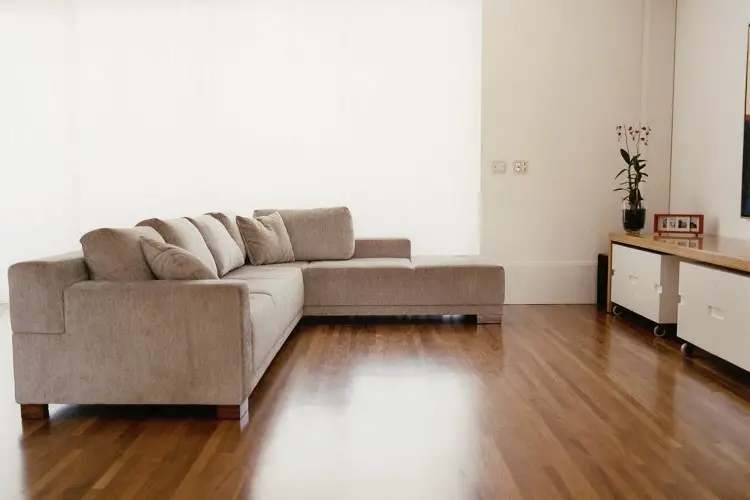Are you thinking of how to stop couch from sliding and you’re looking for the best ways to make on how to make it stop?
A couch is often the centerpiece of a living room, providing comfort and style. However, one common frustration many people experience is the incessant sliding of their couch across the floor.
It can be annoying and even dangerous, leading to potential accidents. If you find yourself constantly readjusting your couch, there are several effective solutions to keep it stable and in place.
In this article, we will explore practical methods to prevent your couch from sliding and enhance your overall living room experience.
How To Stop Couch From Sliding

There are lots of practical ways or methods that can be utilized to prevent your couch from sliding and enhancing your living room experience and they include:
1. Use Furniture Grippers or Non-Slip Pads
Furniture grippers or non-slip pads are a practical and widely used solution to prevent couches from sliding.
These pads are usually made of rubber or silicone and are designed to provide an enhanced grip between the couch legs and the floor.
They work effectively on hardwood, laminate, tile, or any other smooth surface.
To utilize this method, measure the size of the couch legs accurately and choose grippers or pads that match the dimensions.
Place a pad under each leg of the couch, ensuring they adhere securely. The grippers create a frictional barrier, minimizing any lateral movement of the couch and improving stability.
2. Using Velcro Strips or Hook-and-Loop Fasteners
Velcro strips or hook-and-loop fasteners offer a versatile and customizable approach to stabilizing your couch.
Begin by attaching one side of the Velcro to the bottom of each couch leg using adhesive or stitching.
Corresponding Velcro pieces are then attached to the floor at the intended positions. Ensure that the Velcro pieces on the couch legs align with those on the floor.
Press the Velcro strips firmly to create a strong grip between the couch and the floor. This method allows for easy adjustments and removal if needed, making it a convenient choice to keep your couch securely in place.
3. Using Rubber Stoppers or Furniture Coasters
Rubber stoppers or furniture coasters are simple yet effective tools to prevent couches from sliding, especially on hard floors like hardwood or tile.
These stoppers are typically made of rubber or soft materials that provide excellent traction.
Place a rubber stopper under each leg of the couch, ensuring a snug fit.
The rubber material creates a stable base and enhances grip, preventing unwanted movement of the couch. This method is cost-effective and easy to implement.
4. Using Carpet Gripper Tape
If your living space is carpeted, carpet gripper tape can be an excellent solution to keep your couch from sliding on the carpet.
This tape is specifically designed to adhere to carpets and create a secure grip.
Apply strips of carpet gripper tape to the bottom of each couch leg. Press the tape firmly onto the carpet to ensure a strong bond.
The tape will prevent the couch from slipping on the carpet, providing stability and peace of mind.
5. Using Double-Sided Tape or Rug Gripper
Double-sided tape or rug gripper is a versatile option suitable for various floor types, including both hard floors and carpets. Cut the tape into appropriate lengths and apply it to the bottom of each couch leg.
Press the legs firmly onto the floor, allowing the adhesive on both sides of the tape to create a firm bond.
This method is easy to implement and offers a reliable grip, ensuring that your couch remains in place and doesn’t slide around.
6. Use Non-Slip Rugs
Adding a non-slip rug like the Veken Rug to your flooring can prevent your furniture from sliding around. Besides being functional, rugs also enhance the room’s style and visual appeal.
Although rugs are more expensive than other solutions we’ve discussed, they are the best option for covering large areas and securing multiple pieces of furniture.
Rugs offer a soft and comfortable surface without the need for costly carpet installation.
Some rugs have specialized non-slip pads underneath, ensuring that your furniture stays in place. While they may cost a little more, they are worth the price.
7. Utilizing Anti-Slip Fabric
Anti-slip fabric can be used effectively to prevent sliding between the couch cushions and the couch frame. This fabric is often used to line drawers or shelves to prevent items from moving.
Cut the anti-slip fabric into appropriate sizes and place it between the couch cushions and the frame.
The friction created by the anti-slip fabric will keep the cushions in place, minimizing any shifting or sliding.
8. Adjusting Furniture Layout
A practical approach to minimizing couch sliding is to strategically arrange your furniture. Position the couch against a wall or another large piece of furniture to limit movement.
Placing heavy decorative items or additional furniture pieces near the couch can act as natural barriers, reducing the potential for sliding.
By rearranging your furniture layout, you can create a more stable seating arrangement and enhance the overall aesthetics of your living space.
9. Dusting Your Floor
Dust is unhealthy and unpleasant anyway. To top it off, it makes your sectional sofa slide even more.
All the equipment mentioned above can only work well when you keep your home and floors free from dust.
If you have a floor filled with dust, their efficiency will reduce and you would want to know what will happen if you let dust accumulate on a hardwood floor.
Here is it, it can make your sectional sofa slide with the pads on. In addition, dust can not only wear down the grippers and pads but will also damage your flooring. Regular dusting of your floor can make a difference.
10. Use of Stop Blocks
Using stop blocks is extremely beautiful and very effective for recliners and other large pieces of furniture.
One of the reasons why many do not use them frequently is because they are usually more expensive than rubber pads or grippers, but you can also create your stopblocks at home.
All you have to do is simply trace the shape of the furniture legs onto cardboard, then cut out wooden blocks using the patterns.
Placing these blocks in between the furniture and wall will prevent your recliner or couch from moving out of place.
Read Also: Can I Use Pine Sol on Engineered Wood Floors? Explained
Frequent Asked Questions
How Do I Prevent A Sectional Couch From Sliding?
If you have a sectional L-shaped couch on a hardwood or laminate floor, it may slide around when you sit on one side of it.
This is because each section slides off in a different direction, leaving a gap where the pieces connect. To prevent this from happening, you can lay a rug or carpet on the floor and use double rubber pads on each couch leg.
Some models come with hardware to permanently join the sections, or you can use DIY methods to join them together if you have the right tools.
How Do I Prevent A Recliner From Sliding?
To prevent your recliner from slipping on hardwood or laminate flooring, we suggest placing round rubber gripper pads under the feet.
These pads hold the recliner in place when adjusting the chair, preventing it from slipping out under the force of pronating and retracting the seating position.
Rubber grips are highly effective due to their high friction and “stickiness”. They are the best solution for preventing your couch from sliding.
How Can I Prevent Furniture From Sliding On Wood Flooring?
If you have hardwood floors at home and want to prevent your couch from slipping without getting a rug, there are a few solutions you can try.
First, you can attach rubber furniture grippers or use silicone furniture feet. These are easy to install and will help keep your couch in place. Another option is to bolt the couch to the floor, which requires some DIY skills and may cause damage to the flooring.
However, it will permanently stop your couch from sliding on a wood floor. Remember that the friction between plastic, metal, and wood is low, which causes the couch to slip so these solutions can help.
How Can I Prevent My Sofa From Sliding On Laminate Flooring?
Laminate flooring is a great and affordable option if you want your floor to look like hardwood without spending a lot of money.
However, your couch will slip on it in the same way as it would on hardwood. You can use the same methods to prevent it from slipping that you would use with hardwood flooring.
How Do I Prevent a Couch From Sliding On Tile?
If you want to prevent your couch from slipping on tiles, adding a non-slip rug is your best option. It looks stylish and keeps the room warm by limiting heat loss.
If you prefer not to use a rug, there are two other affordable options to keep your couch in place: furniture grippers and silicone leg caps. These solutions work well for vinyl or laminate flooring and won’t damage your floors.
How Do I Prevent Furniture From Sliding On Carpet?
If your couch is sliding on your carpet, it could be because the carpet has a light or smooth design. To prevent this, you can try these solutions:
- Use a non-slip rug underneath the couch.
- Choose a heavy carpet for your floor.
- Place rubber pads under each leg of the couch.
Remember that the way you sit and get up from your couch also affects its movement. So, be mindful of that too.
Final Thought
Knowing how to stop couch from sliding is crucial for both safety and maintaining a well-organized living space.
By implementing any of the above methods, such as using furniture grippers, Velcro strips, rubber stoppers, carpet gripper tape, double-sided tape, anti-slip fabric, or adjusting your furniture layout, you can ensure that your couch stays stable and secure in its position.
Choose the method that suits your floor type and preferences, and enjoy a more stable and hassle-free seating experience on your couch.

